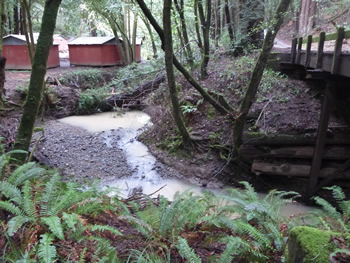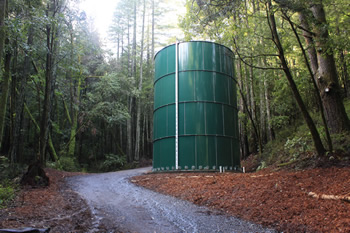Water Resources
Gold Ridge RCD works with local, regional and state partners to improve the quality of our watersheds. The RCD helps landowners to manage their sediment and nutrient contributions to water ways, improve flow within our streams by developing alternatives to groundwater and surface water diversions, enhance the wildlife habitat within and near waterways, and more. Below are descriptions of our work in improving overall watershed health, the quality of water in our district, and the opportunities landowners and residents have to conserve water.
Watershed Health
The RCD holds in mind the concept that  “We are all downstream” when designing plans for watershed health. The RCD pays attention to upstream sources of negative impacts on watershed health such as rural stormwater management, upland habitat quality, and accumulated sedimentation. These upstream impacts affect multiple water quality factors throughout the watershed: water temperature, turbidity, nutrient-load, velocity, quanitity and timing. All of these factors impact the wild and human residents that depend on water resources. The RCD works with the community to manage our local watersheds' health holistically.
“We are all downstream” when designing plans for watershed health. The RCD pays attention to upstream sources of negative impacts on watershed health such as rural stormwater management, upland habitat quality, and accumulated sedimentation. These upstream impacts affect multiple water quality factors throughout the watershed: water temperature, turbidity, nutrient-load, velocity, quanitity and timing. All of these factors impact the wild and human residents that depend on water resources. The RCD works with the community to manage our local watersheds' health holistically.
Sediment Reduction and Erosion Control
Riparian Conservation Easement Program
Water Quality
The RCD uses scientifically sound methods to assess and better-understand water quality in the watershed as it relates to supporting ecological, agricultural, rural and urban uses. Fine sediment and contaminants in urban run-off are the primary focus of our water quality monitoring. Monitoring and assessment results are used to establish credible information for the community and policy makers to consider when making decisions that influence conservation. Information gained from monitoring and assessment is incorporated into our education programs and often leads to conservation and habitat enhancement planning and implementation.
Sediment Reduction and Erosion Control
Water Conservation
Conserving water where we have it and using it responsibly is a major charge for the Gold Ridge RCD. Conservation measures and projects such as protecting groundwater supply, helping to improve water use efficiency, and developing alternative water sources and supplies such as greywater, rainwater and building seasonal water storage are all essential parts of local water conservation during California’s fifth year of drought. 